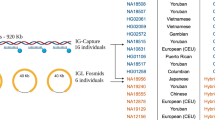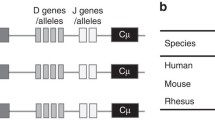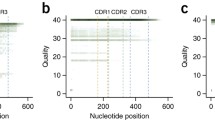Abstract
Complete and accurate knowledge of the genes and allelic variants of the human immunoglobulin gene loci is critical for studies of B cell repertoire development and somatic point mutation, but evidence from studies of VDJ rearrangements suggests that our knowledge of the available immunoglobulin gene repertoire is far from complete. The reported repertoire has changed little over the last 15 years. This is, in part, a consequence of the inefficiencies involved in searching for new members of large, multigenic gene families by cloning and sequencing. The advent of high-throughput sequencing provides a new avenue by which the germline repertoire can be explored. In this report, we describe pyrosequencing studies of the heavy chain IGHV1, IGHV3 and IGHV4 gene subgroups in ten Papua New Guineans. Thousands of 454 reads aligned with complete identity to 51 previously reported functional IGHV genes and allelic variants. A new gene, IGHV3-NL1*01, was identified, which differs from the nearest previously reported gene by 15 nucleotides. Sixteen new IGHV alleles were also identified, 15 of which varied from previously reported functional IGHV genes by between one and four nucleotides, while one sequence appears to be a functional variant of the pseudogene IGHV3-25. BLAST searches suggest that at least six of these new genes are carried within the relatively well-studied populations of North America, Europe or Asia. This study substantially expands the known immunoglobulin gene repertoire and demonstrates that genetic variation of immunoglobulin genes can now be efficiently explored in different human populations using high-throughput pyrosequencing.

Similar content being viewed by others
References
Boyd SD, Gaëta BA, Jackson KJ, Fire AZ, Marshall EL, Merker JD, Maniar JM, Zhang LN, Sahaf B, Jones CD, Simen BB, Hanczaruk B, Nguyen KD, Nadeau KC, Egholm M, Miklos DB, Zehnder JL, Collins AM (2010) Individual variation in the germline Ig gene repertoire inferred from variable region gene rearrangements. J Immunol 184:6986–6992
Brauninger A, Yang W, Wacker HH, Rajewsky K, Kuppers R, Hansmann ML (2001) B-cell development in progressively transformed germinal centers: similarities and differences compared with classical germinal centers and lymphocyte-predominant Hodgkin disease. Blood 97:714–719
Collins AM, Wang Y, Singh V, Yu P, Jackson KJ, Sewell WA (2008) The reported germline repertoire of human immunoglobulin kappa chain genes is relatively complete and accurate. Immunogenetics 60:669–676
Cook GP, Tomlinson IM, Walter G, Riethman H, Carter NP, Buluwela L, Winter G, Rabbitts TH (1994) A map of the human immunoglobulin VH locus completed by analysis of the telomeric region of chromosome 14q. Nat Genet 7:162–168
Corbett SJ, Tomlinson IM, Sonnhammer ELL, Buck D, Winter G (1997) Sequence of the human immunoglobulin diversity (D) segment locus: a systematic analysis provides no evidence for the use of DIR segments, inverted D segments, “minor” D segments or D-D recombination. J Mol Biol 270:587–597
Droege M, Hill B (2008) The Genome Sequencer FLX System–longer reads, more applications, straight forward bioinformatics and more complete data sets. J Biotech 136:3–10
Galan M, Guivier E, Caraux G, Charbonnel N, Cosson JF (2010) A 454 multiplex sequencing method for rapid and reliable genotyping of highly polymorphic genes in large-scale studies. BMC Genomics 11:296
Hamblin TJ, Davis Z, Gardiner A, Oscier DG, Stevenson FK (1999) Unmutated Ig V(H) genes are associated with a more aggressive form of chronic lymphocytic leukemia. Blood 94:1848–1854
Kolar GR, Yokota T, Rossi MI, Nath SK, Capra JD (2004) Human fetal, cord blood, and adult lymphocyte progenitors have similar potential for generating B cells with a diverse immunoglobulin repertoire. Blood 104:2981–2987
Lee CEH, Gaëta B, Malming HR, Bain ME, Sewell WA, Collins AM (2006) Reconsidering the human immunoglobulin heavy-chain locus. 1. An evaluation of the expressed human IGHD gene repertoire. Immunogenetics 57:917–925
Matsuda F, Ishii K, Bourvagnet P, Kuma K, Hayashida H, Miyata T, Honjo T (1998) The complete nucleotide sequence of the human immunoglobulin heavy chain variable region locus. J Exp Med 188:2151–2162
Pallares N, Lefebvre S, Contet V, Matsuda F, Lefranc MP (1999) The human immunoglobulin heavy variable genes. Exp Clin Immunogenet 16:36–60
Redd AJ, Stoneking M (1999) Peopling the Sahul: mtDNA variation in aboriginal Australia and Papua New Guinean populations. Am J Hum Genet 65:808–828
Romo-Gonzalez T, Vargas-Madrazo E (2005) Structural analysis of substitution patterns in alleles of human immunoglobulin VH genes. Mol Immunol 42:1085–1097
Sakano H, Maki R, Kurosawa Y, Roeder W, Tonegawa S (1980) Two types of somatic recombination are necessary for the generation of complete immunoglobulin heavy-chain genes. Nature 286:676–683
Teer JK, Bonnycastle LL, Chines PS, Hansen NF, Aoyama N, Swift AJ, Abaan HO, Albert TJ, Program NCS, Margulies EH, Green ED, Collins FS, Mullikin JC, Biesecker LG (2010) Systematic comparison of three genomic enrichment methods for massively parallel DNA sequencing. Genome Res 20:1420–1431
Tomlinson IM, Cook GP, Carter NP, Elaswarapu R, Smith S, Walter G, Buluwela L, Rabbitts TH, Winter G (1994) Human immunoglobulin VH and D segments on chromosomes 15q11.2 and 16p11.2. Hum Mol Genet 3:853–860
Tonegawa S (1983) Somatic generation of antibody diversity. Nature 302:575–581
Velickovic M, Velickovic Z, Panigoro R, Dunckley H (2009) Diversity of killer cell immunoglobulin-like receptor genes in Indonesian populations of Java, Kalimantan, Timor and Irian Jaya. Tissue Antigens 73:9–16
Vilar MG, Kaneko A, Hombhanje FW, Tsukahara T, Hwaihwanje I, Lum JK (2008) Reconstructing the origin of the Lapita Cultural Complex: mtDNA analyses of East Sepik Province, PNG. J Hum Genet 53:698–708
Wang Y, Jackson KJL, Sewell WA, Collins AM (2008) Many human immunoglobulin heavy-chain IGHV gene polymorphisms have been reported in error. Immunol Cell Biol 86:111–115
Author information
Authors and Affiliations
Corresponding author
Electronics supplementary materials
Below is the link to the electronic supplementary material.
Supplementary Table 1
Numbers of alignments of 454 pyrosequencing reads that align perfectly to previously reported germline genesa (DOC 92 kb)
Supplementary Table 2
Numbers of alignments of 454 pyrosequencing reads that align perfectly to previously reported germline pseudogenes, open reading frames and orphonsa (DOC 70 kb)
Supplementary Table 3
Numbers of 454 pyrosequencing reads that are highly similar to previously reported genes, pseudogenes and orphons (DOC 48 kb)
Supplementary Table 4
Full-length IGHV sequences identified for the first time in this study. The accession numbers of the reference sequence for each gene is shown. Underlined bold letters show extensions of sequences that appear to have been truncated when originally reported. Upper case bold letters show the critical nucleotides that distinguish these alleles from their most similar reported allele. Deletions relative to the most similar reported allele are shown as dashes. The most similar previously reported gene is listed in square brackets, along with details of the features that distinguish it from the sequence reported in this study (DOC 40.5 kb)
Rights and permissions
About this article
Cite this article
Wang, Y., Jackson, K.J., Gäeta, B. et al. Genomic screening by 454 pyrosequencing identifies a new human IGHV gene and sixteen other new IGHV allelic variants. Immunogenetics 63, 259–265 (2011). https://doi.org/10.1007/s00251-010-0510-8
Received:
Accepted:
Published:
Issue Date:
DOI: https://doi.org/10.1007/s00251-010-0510-8




